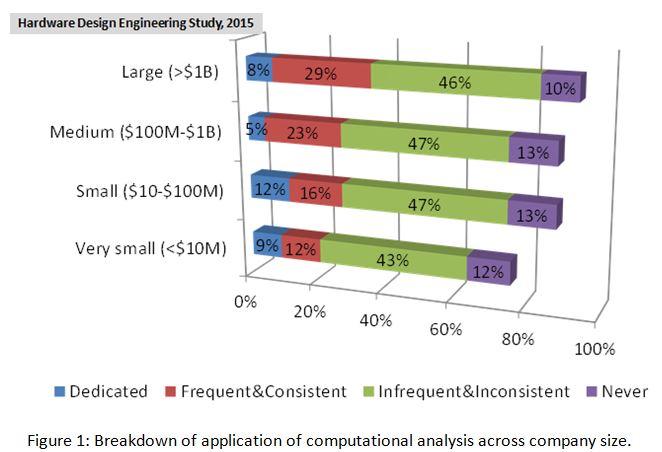Modeling and Simulation: Opportunity
“It’s not just what you do it’s also why you do it” – Part 2
With all these advantages of modeling and simulation that were documented in Part 1 of this blog where is computational analysis and virtual prototyping being used and what is the opportunity for future use? A 2015 study (1) (Figure 1), suggested that in leading companies computational analysis has made significant inroads into general use but there are many areas where it is not being applied.
Although the data show a reasonably consistent use of modeling and simulation across all company sizes with “dedicated” and “frequent and consistent” use, by far the largest percentage in the study shows “infrequent and inconsistent”. Although it is recognized that modeling and simulation provides value to an organization there are many functional areas where it is not being applied and instead organizations remain reliant on traditional approaches such as “rules of thumb”, experience or spreadsheet based calculations. One reason for this is that computational analysis is viewed as the domain of an expert and in many cases expert knowledge is required to gain access to the appropriate software. Thus a major growth area for the use of modeling and simulation requires that the expertise embedded in computational models be made more readily available for use by personnel with limited expertise in computational modeling. By bridging this gap, design and process engineers can take advantage of predictive physics-based results earlier in the design process, make more accurate decisions about the developments and thereby reduce the extent of prototype testing and evaluation that is required.
To accomplish this objective two primary components of the problem need to be addressed: first, approaches that enable computational analyses developed by experts to be used by scientists and engineers who may have limited experience with computational analysis; and secondly, mechanisms by which computational analyses can be widely distributed without the need to invest in the hardware, software and personnel required to effectively operate them. For the remainder of this article we focus on the first of these areas, a future article will center on the topic of packaging the product for use by a wider audience.
It is estimated that globally there are~750,000 computational simulation experts but there are ~80 million scientists and engineers who can make use of computational analysis. How can computational simulation based tools be made available for use by this large group? One method to facilitate the spread of computational analysis is to package the expert’s knowledge into easy to use computational analysis files that use simplified interfaces to set up analyses of selected problems. This allows design and process engineers to run a series of analyses easily and use the results to aid decisions on developments without having to make direct use of computational analysis domain experts. This approach has recently become a viable option through the release of a number of platforms that allow the development and distribution of packaged Computational Simulation Applications (CApps) that can fall into two categories; first those that are maintained as proprietary within an organization, and secondly, general ones that seek to provide results across a generic industry problem.
Recently, AltaSim has developed a range of CApps to address technology associated with:
- Heat sink design
- Quenching on metal components
- CMC RMI processing
- Mass transport through barrier layers
- Additive manufacturing
- Plasma devices
These CApps are based on computational analyses developed using COMSOL Multiphysics that are then adapted using the COMSOL Application Builder to produce CApps that can be run using a COMSOL Multiphysics or COMSOL Server license. A simplified interface, eg Figure 2, allows the user to quickly and easily define the input parameters and conditions for an analysis to examine the effect of heat sink design on dissipation of thermal energy from electronic components using HeatSinkSim.
Once the problem set up is confirmed, analysis is automatically performed using verified conditions defined by the computational analysis expert. In this case the analysis solves the natural convection problem and incorporates thermal dissipation due to conduction, convection and radiation to the surrounding environment to allow the effect of the design of a heat sink on the thermal distribution to be defined. Previously these calculations incorporated gross assumptions on heat transfer coefficients, extrapolated form 1-D solutions and neglected critical factors such as radiation. Use of HeatSinkSim has enabled designers to identify options and limitations earlier in the design process, and safely operate under conditions that approach component limits thus allowing more functionality and smaller product forms to be utilized.
In summary, the motivation for using computational analysis is becoming clearer and more quantified: integration into the development cycle provides advantages in the critical areas of product launch date, cost of development and product quality. This advantage is being used by leading companies to establish, gain and protect market share at the expense of those companies who ignore the benefits of modeling and simulation. In companies where modeling and simulation is established there remains a significant opportunity to extend its reach by replacing traditional engineering based approximations that may have been codified in company guidelines, industry codes of practice or individual spreadsheets by predictive physics based computational analysis. Computational Applications can capture expert knowledge and present it in a way that it is easily and readily accessible for use by a wider group of scientists and engineers who can then make informed decisions during the development and implementation of new technology.
References:
- Hardware design engineering study, Lifecycle Insights, August, 2015


